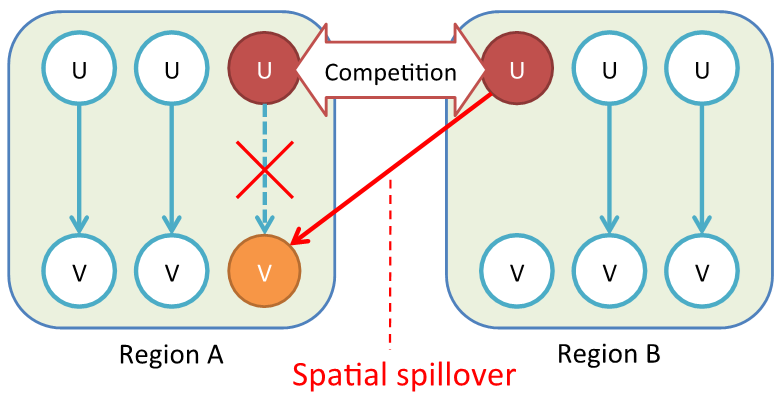Research Highlights (Yudai Higashi)
1. Job matching in local labor markets
Local labor markets are not considered to be independent but spatially interdependent. Accounting for such spatial interdependence, I studied the matching of job seekers and vacancies in local labor markets.
Higashi (2018) shows that job matching in a local region is affected by unemployment and vacancies in neighboring regions in addition to those in its own region. This spatial spillover effect suggests that due to inter-regional job searches, job seekers in the local region compete with their counterparts in neighboring regions (Figure 1). Furthermore, the Great East Japan Earthquake temporarily boosted the magnitude of spatial spillovers in job matching around the damaged areas.
Higashi (2020a) shows that the Great East Japan Earthquake increased labor market tightness and deteriorated matching efficiencies not only in the directly damaged areas but also in adjacent areas.

Figure 1: Spatial spillover effect in job matching
2. Job search and agglomeration effects
Higashi (2020b) examines the effects of industrial agglomeration on a non-working individual’s decision to search for a job. This study focuses on the difference in the agglomeration effects across heterogenous individual attributes.
References
[1] Higashi, Y. (2018) “Spatial spillovers in job matching: Evidence from the Japanese local labor markets,” Journal of the Japanese and International Economies, 50: 1–15.
[2] Higashi, Y. (2020a) “Effects of region-specific shocks on labor market tightness and matching efficiency: Evidence from the 2011 Tohoku Earthquake in Japan,” Annals of Regional Science, 65(1): 193–219.
[3] Higashi, Y. (2020b) “Urbanization effects on job search decision,” RIEB Discussion Paper Series, No. 2020-26.
